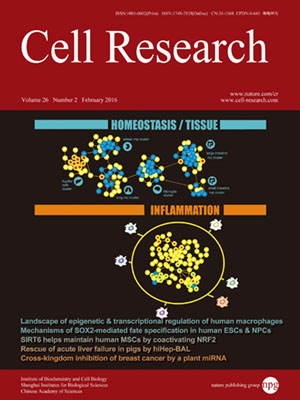
Volume 26, No 2, Feb 2016
ISSN: 1001-0602
EISSN: 1748-7838 2018
impact factor 17.848*
(Clarivate Analytics, 2019)
Volume 26 Issue 2, February 2016: 206-216 | Open Access
ORIGINAL ARTICLES
Improved survival of porcine acute liver failure by a bioartificial liver device implanted with induced human functional hepatocytes
Xiao-Lei Shi1,*, Yimeng Gao2,*, Yupeng Yan2,*, Hucheng Ma1,*, Lulu Sun2,*, Pengyu Huang2,3,*, Xuan Ni4, Ludi Zhang2, Xin Zhao1, Haozhen Ren1, Dan Hu5, Yan Zhou5, Feng Tian6, Yuan Ji6, Xin Cheng2, Guoyu Pan4, Yi-Tao Ding1 and Lijian Hui2,3
1Department of Hepatobiliary Surgery, the Affiliated Drum Tower Hospital, Medical School of Nanjing University, Nanjing, Jiangsu, China
2State Key Laboratory of Cell Biology, Shanghai Institute of Biochemistry and Cell Biology, Shanghai Institutes for Biological Sciences, Chinese Academic of Sciences, Shanghai 200031, China
3School of Life Science and Technology, ShanghaiTech University, Shanghai, China
4Center for Drug Safety Evaluation and Research, Shanghai Institute of Materia Medica, Chinese Academy of Sciences, Shanghai, China
5State Key Laboratory of Bioreactor Engineering, School of Bioengineering, East China University of Science and Technology, Shanghai, China
6Department of Pathology, Zhongshan Hospital, Fudan University, Shanghai, China
Correspondence: Lijian Hui, E-mail: ljhui@sibcb.ac.cn; Yi-Tao Ding, E-mail: yitaoding@hotmail.com; Guoyu Pan,(gypan@cdser.simm.ac.cn)
Acute liver failure (ALF) is a life-threatening illness. The extracorporeal cell-based bioartificial liver (BAL) system could bridge liver transplantation and facilitate liver regeneration for ALF patients by providing metabolic detoxification and synthetic functions. Previous BAL systems, based on hepatoma cells and non-human hepatocytes, achieved limited clinical advances, largely due to poor hepatic functions, cumbersome preparation or safety concerns of these cells. We previously generated human functional hepatocytes by lineage conversion (hiHeps). Here, by improving functional maturity of hiHeps and producing hiHeps at clinical scales (3 billion cells), we developed a hiHep-based BAL system (hiHep-BAL). In a porcine ALF model, hiHep-BAL treatment restored liver functions, corrected blood levels of ammonia and bilirubin, and prolonged survival. Importantly, human albumin and α-1-antitrypsin were detectable in hiHep-BAL-treated ALF pigs. Moreover, hiHep-BAL treatment led to attenuated liver damage, resolved inflammation and enhanced liver regeneration. Our findings indicate a promising clinical application of the hiHep-BAL system.
10.1038/cr.2016.6
FULL TEXT | PDF
Browse 2779


